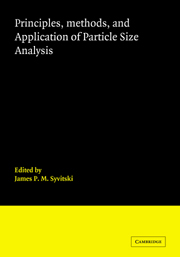Book contents
- Frontmatter
- Contents
- List of contributors
- Preface
- Acknowledgments
- I Introduction
- II Theory and methods
- III In situ methods
- IV Data interpretation and manipulation
- 16 Suite statistics: The hydrodynamic evolution of the sediment pool
- 17 The hyperbolic distribution
- 18 Factor analysis of size frequency distributions: Significance of factor solutions based on simulation experiments
- 19 Experimental–theoretical approach to interpretation of grain size frequency distributions
- V Applications
- Index
18 - Factor analysis of size frequency distributions: Significance of factor solutions based on simulation experiments
Published online by Cambridge University Press: 28 January 2010
- Frontmatter
- Contents
- List of contributors
- Preface
- Acknowledgments
- I Introduction
- II Theory and methods
- III In situ methods
- IV Data interpretation and manipulation
- 16 Suite statistics: The hydrodynamic evolution of the sediment pool
- 17 The hyperbolic distribution
- 18 Factor analysis of size frequency distributions: Significance of factor solutions based on simulation experiments
- 19 Experimental–theoretical approach to interpretation of grain size frequency distributions
- V Applications
- Index
Summary
Factor analysis is often considered a part of statistical methodology. But in view of the fervor shown by its advocates as well as by its detractors, it is suggested that factor analysis might better be classified as a religion.
(Wallis, 1968)Introduction
Many factors influence the size frequency distribution (SFD) of natural sediment populations. Solohub & Klovan (1970) list:
distribution of the source material;
mineralogy and texture of the source material;
the type and amount of energy at a depositional site;
the rate of sediment supply;
the possibility of sediment removal;
the mixing, sorting, and remixing of separate populations; and
digenetic alterations.
The scale and nature of sampling can also be very important (Grace et al., 1978). Analysis of the SFD of sedimentary particles remains an important tool for understanding sedimentary processes despite the varying degrees of success achieved by its application. Methods include interpreting bivariate plots of “statistical” parameters derived from SFD, or the shape of individual SFD, to more complex multivariate methods, such as factor or discriminate analyses.
Despite the potential pitfalls of the method (Ehrenberg, 1962; Matalas & Reiher, 1967; Glaister & Nelson, 1974; Temple, 1978), Q-mode factor analysis has provided useful geologic information (Klovan, 1966; Yorath, 1967; Beall, 1970; Allen et al., 1971; Clague, 1976; Dal Cin, 1976; Chambers & Upchurch, 1979). Its application, as with most of the other techniques involving size frequency data, has been based on empirical evidence; the results seem to make “sense.”
Information
- Type
- Chapter
- Information
- Principles, Methods and Application of Particle Size Analysis , pp. 249 - 263Publisher: Cambridge University PressPrint publication year: 1991
Accessibility standard: Unknown
Why this information is here
This section outlines the accessibility features of this content - including support for screen readers, full keyboard navigation and high-contrast display options. This may not be relevant for you.Accessibility Information
- 5
- Cited by
